2014 DODGE CHALLENGER fuel cap
[x] Cancel search: fuel capPage 440 of 539

ONBOARD DIAGNOSTIC SYSTEM — OBD II
Your vehicle is equipped with a sophisticated onboard
diagnostic system called OBD II. This system monitors
the performance of the emissions, engine, and automatic
transmission control systems. When these systems are
operating properly, your vehicle will provide excellent
performance and fuel economy, as well as engine emis-
sions well within current government regulations.
If any of these systems require service, the OBD II system
will turn on the “Malfunction Indicator Light” (MIL). It
will also store diagnostic codes and other information to
assist your service technician in making repairs. Al-
though your vehicle will usually be drivable and not
need towing, see your authorized dealer for service as
soon as possible.
CAUTION!
•Prolonged driving with the MIL on could cause
further damage to the emission control system. It
could also affect fuel economy and driveability.
The vehicle must be serviced before any emissions
tests can be performed.
• If the MIL is flashing while the engine is running,
severe catalytic converter damage and power loss
will soon occur. Immediate service is required.
Loose Fuel Filler Cap
If the vehicle diagnostic system determines that the fuel
filler cap is loose, improperly installed, or damaged, a
”gASCAP” message will display in the odometer or a
“Check Gascap” message will display in the Electronic
Vehicle Information Center (EVIC) (if equipped). If this
occurs, tighten the fuel filler cap properly and press the
438 MAINTAINING YOUR VEHICLE
Page 441 of 539

Trip Odometer button to turn off the message. If the
problem continues, the message will appear the next time
the vehicle is started.
A loose, improperly installed, or damaged fuel filler cap
may also turn on the MIL.
EMISSIONS INSPECTION AND MAINTENANCE
PROGRAMS
In some localities, it may be a legal requirement to pass
an inspection of your vehicle’s emissions control system.
Failure to pass could prevent vehicle registration.For states that require an Inspection and Mainte-
nance (I/M), this check verifies the “Malfunction
Indicator Light (MIL)” is functioning and is not
on when the engine is running, and that the OBD II
system is ready for testing. Normally, the OBD II system will be ready. The OBD II
system may
notbe ready if your vehicle was recently
serviced, recently had a dead battery or a battery replace-
ment. If the OBD II system should be determined not
ready for the I/M test, your vehicle may fail the test.
Your vehicle has a simple ignition actuated test, which
you can use prior to going to the test station. To check if
your vehicle’s OBD II system is ready, you must do the
following:
1. Cycle the ignition switch to the ON position, but do not crank or start the engine.
NOTE: If you crank or start the engine, you will have to
start this test over.
2. As soon as you cycle the ignition switch to the ON position, you will see the MIL symbol come on as part
of a normal bulb check.
7
MAINTAINING YOUR VEHICLE 439
Page 446 of 539
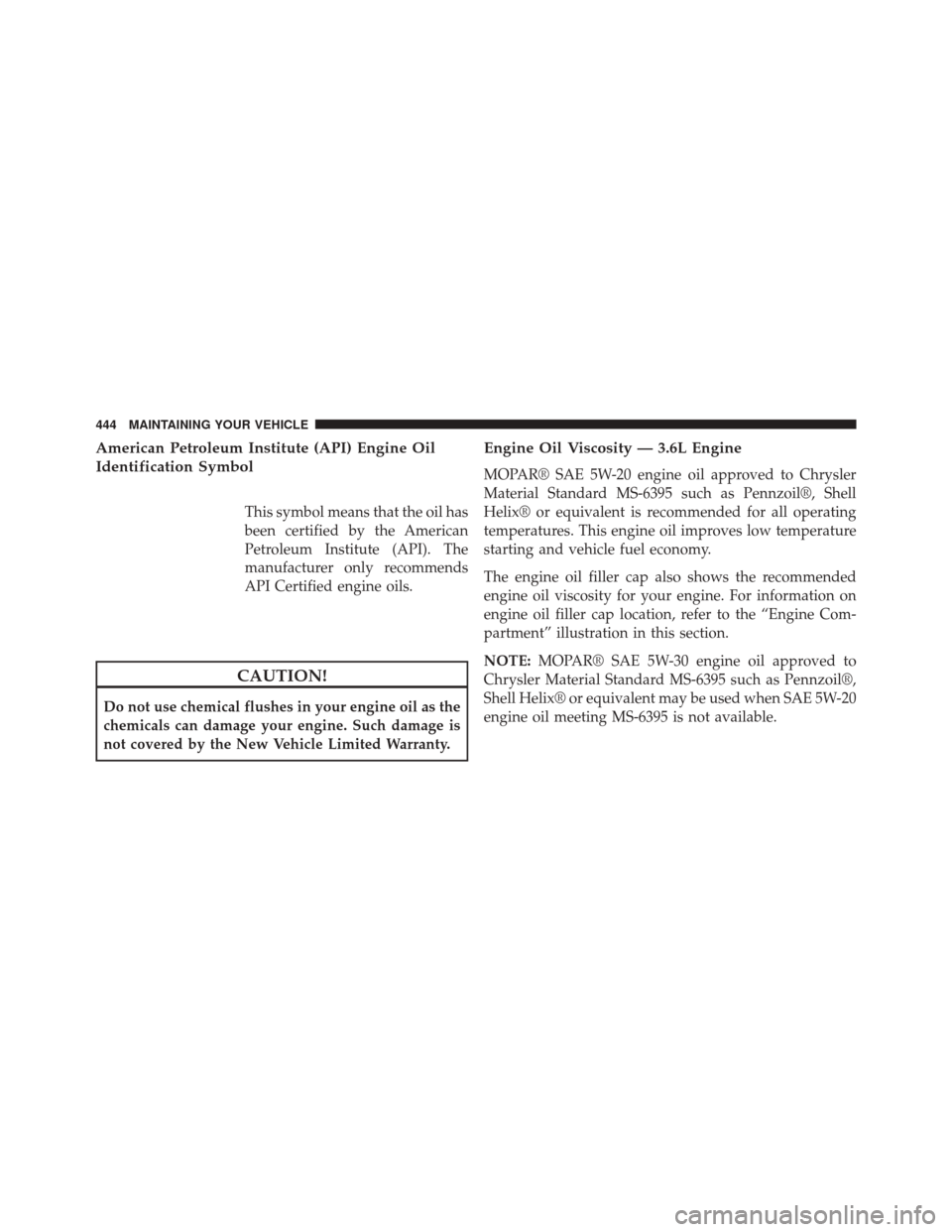
American Petroleum Institute (API) Engine Oil
Identification Symbol
This symbol means that the oil has
been certified by the American
Petroleum Institute (API). The
manufacturer only recommends
API Certified engine oils.
CAUTION!
Do not use chemical flushes in your engine oil as the
chemicals can damage your engine. Such damage is
not covered by the New Vehicle Limited Warranty.
Engine Oil Viscosity — 3.6L Engine
MOPAR® SAE 5W-20 engine oil approved to Chrysler
Material Standard MS-6395 such as Pennzoil®, Shell
Helix® or equivalent is recommended for all operating
temperatures. This engine oil improves low temperature
starting and vehicle fuel economy.
The engine oil filler cap also shows the recommended
engine oil viscosity for your engine. For information on
engine oil filler cap location, refer to the “Engine Com-
partment” illustration in this section.
NOTE:MOPAR® SAE 5W-30 engine oil approved to
Chrysler Material Standard MS-6395 such as Pennzoil®,
Shell Helix® or equivalent may be used when SAE 5W-20
engine oil meeting MS-6395 is not available.
444 MAINTAINING YOUR VEHICLE
Page 447 of 539
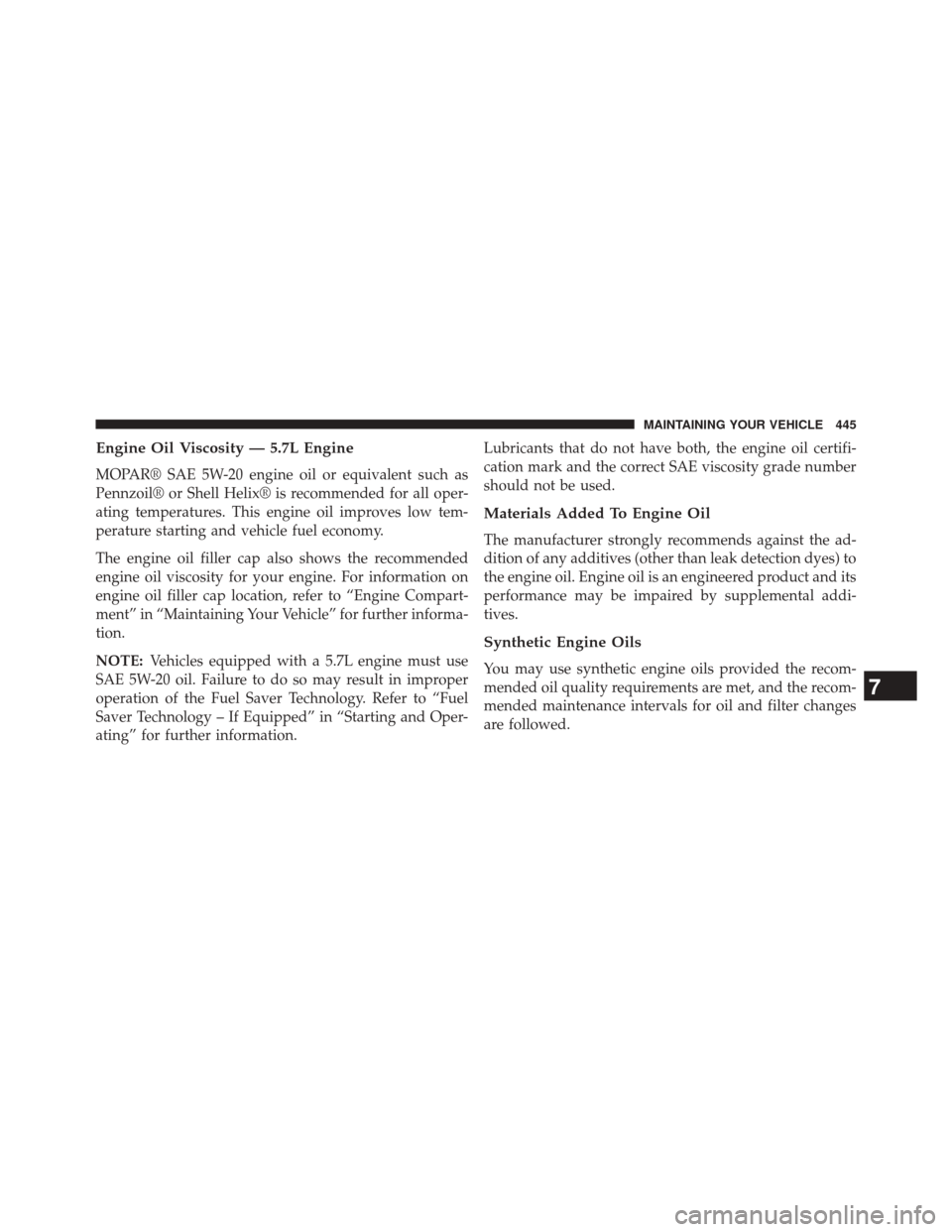
Engine Oil Viscosity — 5.7L Engine
MOPAR® SAE 5W-20 engine oil or equivalent such as
Pennzoil® or Shell Helix® is recommended for all oper-
ating temperatures. This engine oil improves low tem-
perature starting and vehicle fuel economy.
The engine oil filler cap also shows the recommended
engine oil viscosity for your engine. For information on
engine oil filler cap location, refer to “Engine Compart-
ment” in “Maintaining Your Vehicle” for further informa-
tion.
NOTE:Vehicles equipped with a 5.7L engine must use
SAE 5W-20 oil. Failure to do so may result in improper
operation of the Fuel Saver Technology. Refer to “Fuel
Saver Technology – If Equipped” in “Starting and Oper-
ating” for further information. Lubricants that do not have both, the engine oil certifi-
cation mark and the correct SAE viscosity grade number
should not be used.
Materials Added To Engine Oil
The manufacturer strongly recommends against the ad-
dition of any additives (other than leak detection dyes) to
the engine oil. Engine oil is an engineered product and its
performance may be impaired by supplemental addi-
tives.
Synthetic Engine Oils
You may use synthetic engine oils provided the recom-
mended oil quality requirements are met, and the recom-
mended maintenance intervals for oil and filter changes
are followed.
7
MAINTAINING YOUR VEHICLE 445
Page 493 of 539
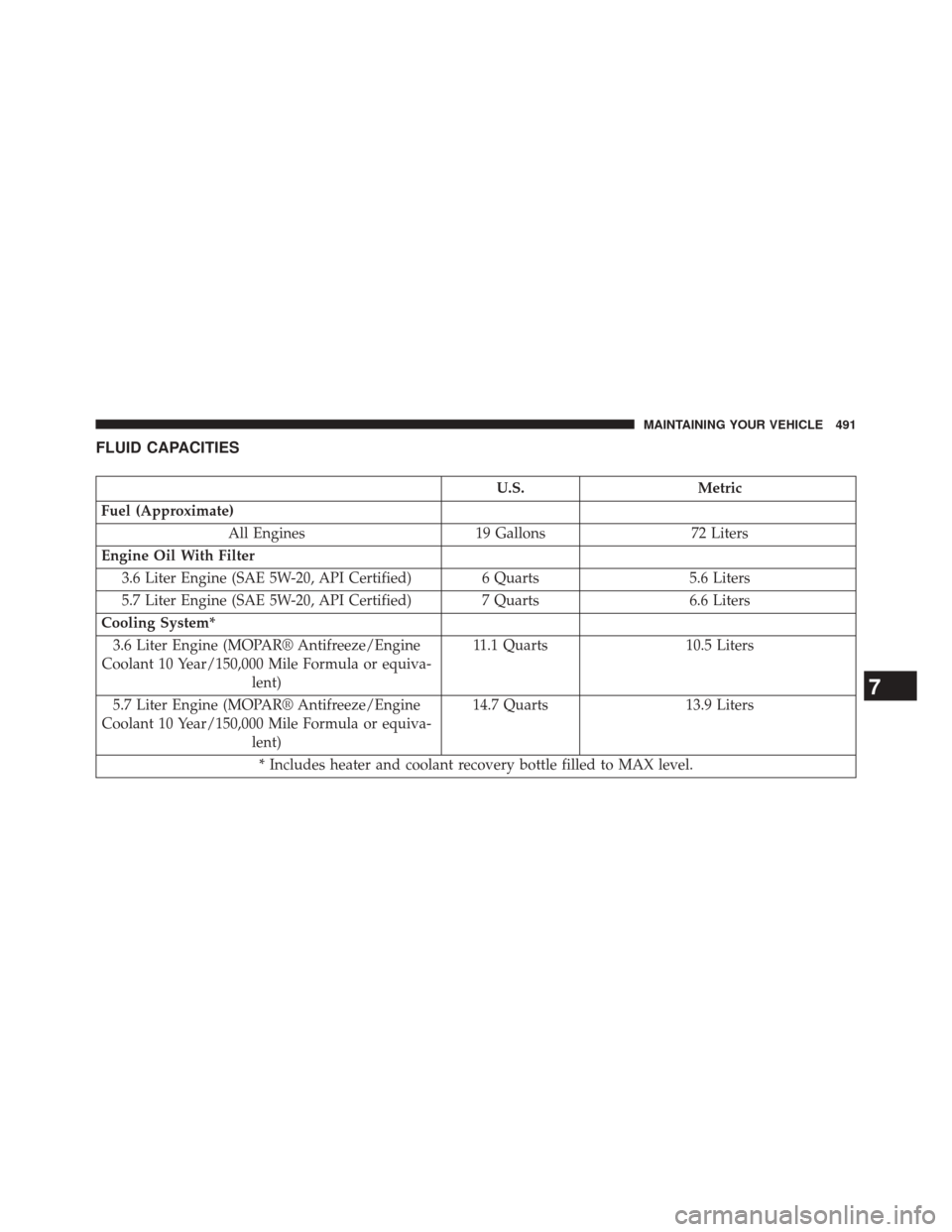
FLUID CAPACITIES
U.S.Metric
Fuel (Approximate) All Engines 19 Gallons72 Liters
Engine Oil With Filter 3.6 Liter Engine (SAE 5W-20, API Certified) 6 Quarts 5.6 Liters
5.7 Liter Engine (SAE 5W-20, API Certified) 7 Quarts 6.6 Liters
Cooling System* 3.6 Liter Engine (MOPAR® Antifreeze/Engine
Coolant 10 Year/150,000 Mile Formula or equiva- lent) 11.1 Quarts
10.5 Liters
5.7 Liter Engine (MOPAR® Antifreeze/Engine
Coolant 10 Year/150,000 Mile Formula or equiva- lent) 14.7 Quarts
13.9 Liters
* Includes heater and coolant recovery bottle filled to MAX level.
7
MAINTAINING YOUR VEHICLE 491
Page 520 of 539
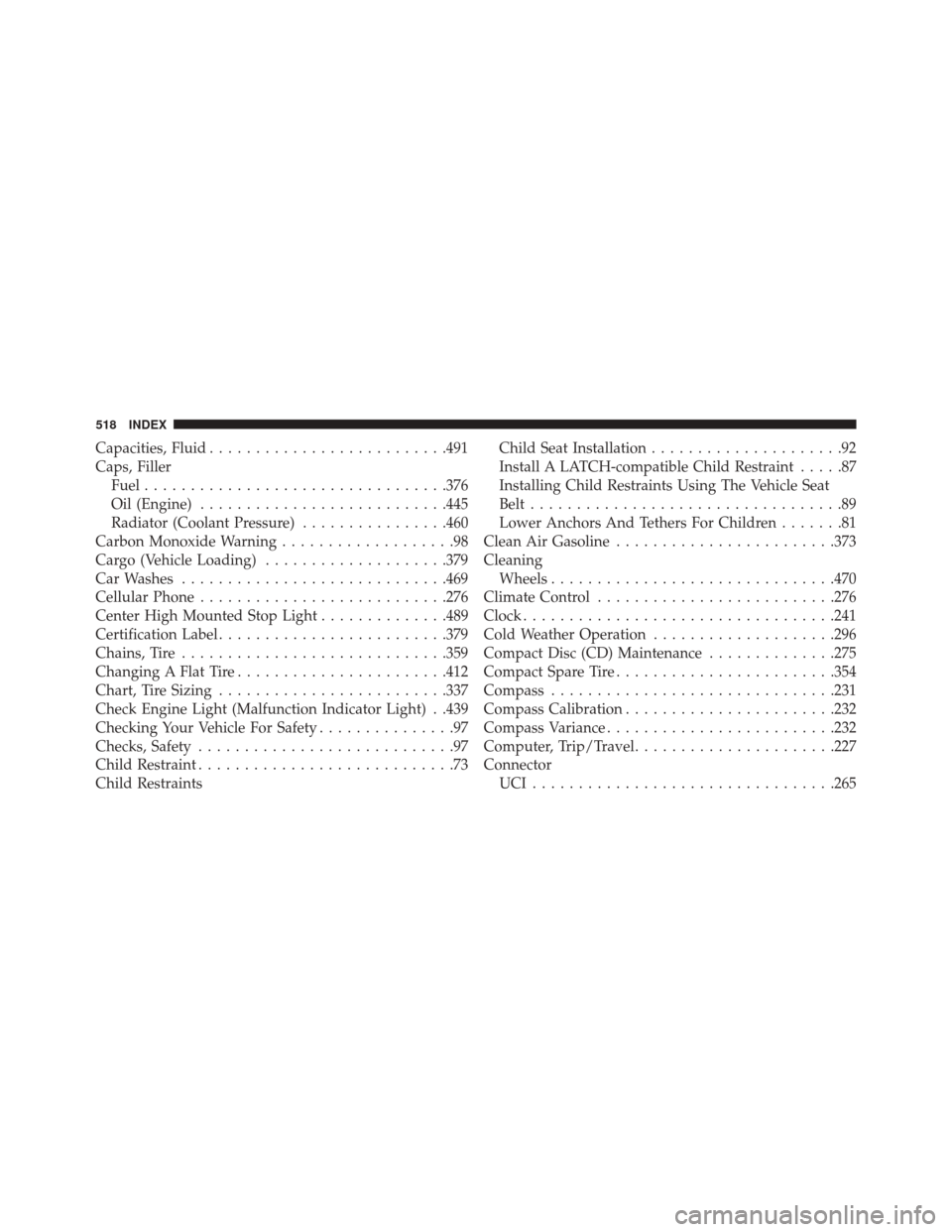
Capacities, Fluid......................... .491
Caps, Filler Fuel ................................ .376
Oil (Engine) .......................... .445
Radiator (Coolant Pressure) ................460
Carbon Monoxide Warning ...................98
Cargo (Vehicle Loading) ....................379
Car Washes ............................ .469
Cellular Phone .......................... .276
Center High Mounted Stop Light ..............489
Certification Label ........................ .379
Chains, Tire ............................ .359
Changing A Flat Tire ...................... .412
Chart, Tire Sizing ........................ .337
Check Engine Light (Malfunction Indicator Light) . .439
Checking Your Vehicle For Safety ...............97
Checks, Safety ............................97
Child Restraint ............................73
Child Restraints Child Seat Installation
.....................92
Install A LATCH-compatible Child Restraint .....87
Installing Child Restraints Using The Vehicle Seat
Belt ..................................89
Lower Anchors And Tethers For Children .......81
Clean Air Gasoline ....................... .373
Cleaning Wheels .............................. .470
Climate Control ......................... .276
Clock ................................. .241
Cold Weather Operation ....................296
Compact Disc (CD) Maintenance ..............275
Compact Spare Tire ....................... .354
Compass .............................. .231
Compass Calibration ...................... .232
Compass Variance ........................ .232
Computer, Trip/Travel ..................... .227
Connector UCI................................ .265
518 INDEX
Page 521 of 539

Universal Consumer Interface (UCI)..........265
Conserving Fuel ......................... .227
Console ............................... .202
Console, Floor .......................... .202
Console, Overhead ....................... .184
Contract, Service ......................... .509
Coolant Pressure Cap (Radiator Cap) ...........460
Cooling System .......................... .456
Adding Coolant (Antifreeze) ...............458
Coolant Capacity ...................... .491
Coolant Level ......................... .456
Disposal of Used Coolant .................460
Drain, Flush, and Refill ...................457
Inspection ........................... .461
Points to Remember .....................461
Pressure Cap ......................... .460
Radiator Cap ......................... .460
Selection of Coolant (Antifreeze) .............457
Corrosion Protection ...................... .468Cruise Light
............................ .210
Cupholders ............................ .201
Customer Assistance ...................... .507
Data Recorder, Event .......................72
Daytime Brightness, Interior Lights .............168
Daytime Running Lights ....................163
Dealer Service ........................... .440
Deck Lid, Emergency Release .................44
Deck Lid, Power Release .....................43
Defroster, Rear Window .....................203
Defroster, Windshield .......................99
Delay (Intermittent) Wipers ..................169
Diagnostic System, Onboard .................438
Dimmer Switch, Headlight ...................166
Dipsticks Oil (Engine) .......................... .442
Disabled Vehicle Towing ................... .429
10
INDEX 519
Page 523 of 539
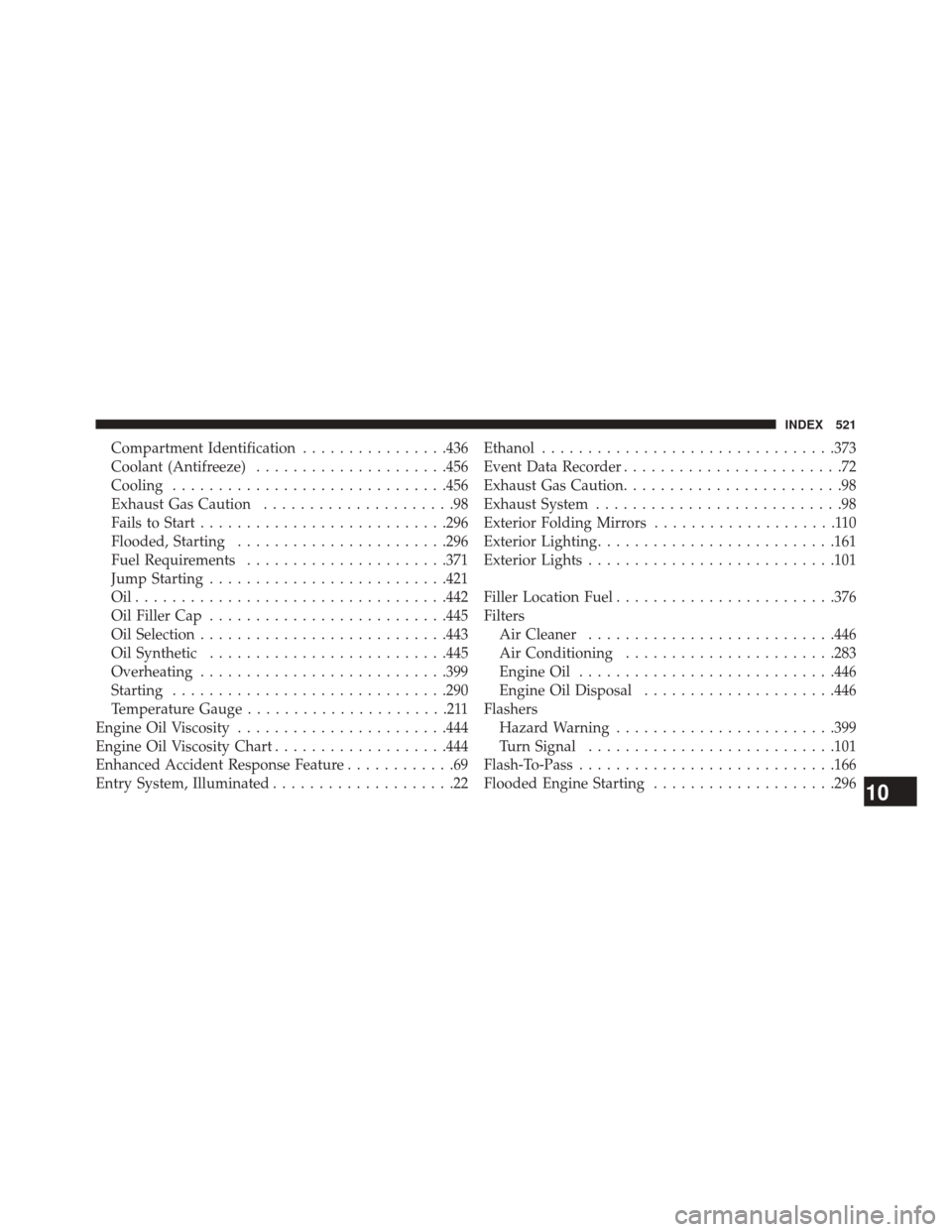
Compartment Identification................436
Coolant (Antifreeze) .....................456
Cooling ............................. .456
Exhaust Gas Caution .....................98
Fails to Start .......................... .296
Flooded, Starting ...................... .296
Fuel Requirements ..................... .371
Jump Starting ......................... .421
Oil................................. .442
Oil Filler Cap ......................... .445
Oil Selection .......................... .443
Oil Synthetic ......................... .445
Overheating .......................... .399
Starting ............................. .290
Temperature Gauge ......................211
Engine Oil Viscosity ...................... .444
Engine Oil Viscosity Chart ...................444
Enhanced Accident Response Feature ............69
Entry System, Illuminated ....................22 Ethanol
............................... .373
Event Data Recorder ........................72
Exhaust Gas Caution ........................98
Exhaust System ...........................98
Exterior Folding Mirrors ....................110
Exterior Lighting ......................... .161
Exterior Lights .......................... .101
Filler Location Fuel ....................... .376
Filters Air Cleaner .......................... .446
Air Conditioning ...................... .283
Engine Oil ........................... .446
Engine Oil Disposal .....................446
Flashers Hazard Warning ....................... .399
Turn Signal .......................... .101
Flash-To-Pass ........................... .166
Flooded Engine Starting ....................296
10
INDEX 521